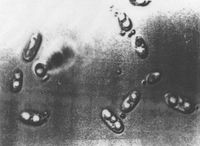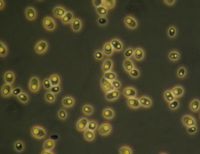OIl producing yeasts
A small fraction of the roughly 2000 describes species of yeast are capable of producing lots of oil in the form of triacyl glycerols, which they keep in droplets as a storage of energy for the future (most yeasts produce glycogen as a carbon/energy store). These oil accumulating yeasts are defined as oleaginous.
We started working with such yeasts in the early 1990s. In our research back then we focused on oleaginous yeasts as lipid rich feed and probiotics in aquaculture.
After many years doing other research, we restarted the work on oil yeasts and isolated oleaginous strains from exotic plants. These were screened for growth on different substrates, oil production and pentose (xylose) degradation. The best were studied in more detail. We have in our collection a number of oleaginous yeasts.
These can efficiently transform different raw material as substrates based on agricultural or forrest waste material, to oil in the form of so called triacyl glycerols, which is the same as in e.g plant based oils
The fatty acid composition resembles that of olive and rapeseed oil, i.e high in C18:1 (monounsaturated FA) and also contains some higher degree of unsaturation.
A high lipid content means a high energy content (which we verified by bomb calorimetry) – suitable for e.g a component in feed, aquaculture included.
The oil can also be transformed into biodiesel (fatty acid methyl esters, FAM), in other words fuel.
There is also a potential for using yeast oil as ingredient in human food. Since yeasts are also rich in micronutrients such as B-vitamins, this would be a nutrient and energy rich ingredient. We are open to explore this with interested partner.
Our oil yeast species can utilize pentose sugars (C5) as well as hexoses (C6). Some of the strains grow well on both sugar types and at the same time using both. This is unusual and relevant for substrates based on lignocellulose and hemicellulose.
Some of our oleaginous strains have xylanase-aktivitet – important for degrading chains of pentoses (common in lignocellulose-based substrates) and transforming to oil. This property may also be explored for production of oligopentoses that may be valuable as prebiotics.
Key References
1995 Enthalpy content as a function of lipid accumulation in Rhodotorula glutinis
T Andlid, C Larsson, C Liljenberg, I Marison, L Gustafsson
Applied microbiology and biotechnology 42, 818-825
2022 Screening of xylose utilizing and high lipid producing yeast strains as a potential candidate for industrial application
L Qvirist, F Mierke, R Vazquez Juarez, T Andlid (2022)
BMC microbiology 22 (1), 1-14
2023 Functional genome annotation and transcriptome analysis of Pseudozyma hubeiensis BOT-O, an oleaginous yeast that utilizes glucose and xylose at equal rates (2023)
F Mierke, DP Brink, J Norbeck, V Siewers, T Andlid
Fungal Genetics and Biology 166, 103783
2023 Expanding the genetic toolbox of Rhodotorula toruloides by identification and validation of six novel promoters induced or repressed under nitrogen starvation (2023) Daniel P. Brink, Friederike Mierke, Joakim Norbeck, Verena Siewers and Thomas Andlid
Microbial Cell Factories, submitted
Photos from the top: (i) plates with the oil producing red yeast Rhodosporidium toruloides, (ii) microscopy photo of Rodotorula glutinis with intracellular droplets of oil and (iii) Microscopy photo of another of our oil producing yeast with large intracellular dropletts of oil.

